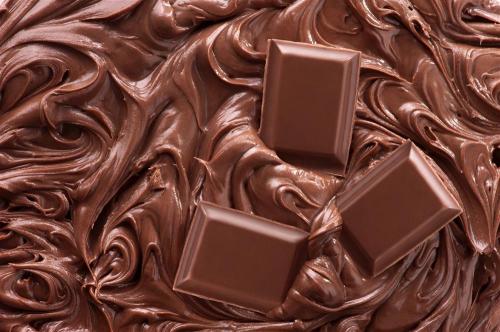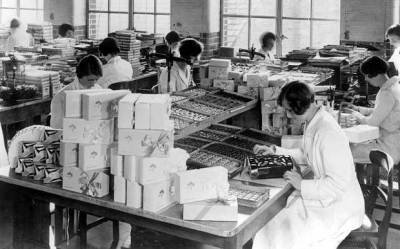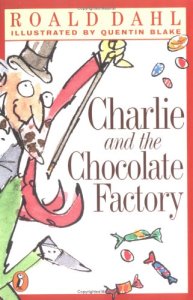
Roald Dahl (1916-1990), one of the world’s best storytellers for children, among illustrations for his books by Quentin Blake. Undated photo.
British children’s writer Roald Dahl ate chocolates and sweets “pretty much every mealtime,” remembers daughter Ophelia Dahl:
“He…was fascinated by the cross section of the Mars bar – the layers of chocolate, caramel and nougat. He would never just bite it, but always cut it and have a look at it like it was a section of the Earth.” (1)
After dinner, whether dining alone or entertaining guests, Dahl would pass around a little red plastic box full of Mars Bars, Milky Ways, Maltesers, Kit Kats and much more.
He knew the history of all the sweets and could tell you exactly when they were invented. 1937 was a big year when Kit Kats (his favorite), Rolos, and Smarties (his dog, Chopper’s favorite) were invented. He wrote a history of chocolate, lecturing schoolchildren to commit such dates to memory such as 1928 when “Cadbury’s Fruit and Nut bar popped up on the scene,” (2) saying,
“Don’t bother with the Kings and Queens of England. All of you should learn these dates instead. Perhaps the Headmistress will see from now on that it becomes part of the major teaching in this school.” (3)
According to Dahl, the Golden Years of Chocolate were 1930-1937. In 1930, Roald Dahl was 14 years old. He was a student at Repton, a prestigious boys’ boarding school in England. It was a harsh environment: those in authority were more interested in controlling than educating the students. In Boy: Tales of Childhood, Dahl writes :
“By now, I am sure you will be wondering why I lay so much emphasis upon school beatings….The answer is that I cannot help it. All through my school life I was appalled by the fact that masters and senior boys were allowed literally to wound other boys, and sometimes quite severely. I couldn’t get over it. I never have got over it. It would, of course, be unfair to suggest that all masters were constantly beating the daylights out of all the boys in those days. They weren’t. Only a few did so, but that was quite enough to leave a lasting impression of horror upon me.”
 Ironically, it was at this difficult period that chocolate became Dahl’s passion. Near Repton was a Cadbury chocolate factory. Every so often, Cadbury would send each schoolboy a sampler box of new chocolates to taste and grade. They were using the students – “the greatest chocolate bar experts in the world” to test out their new inventions.
Ironically, it was at this difficult period that chocolate became Dahl’s passion. Near Repton was a Cadbury chocolate factory. Every so often, Cadbury would send each schoolboy a sampler box of new chocolates to taste and grade. They were using the students – “the greatest chocolate bar experts in the world” to test out their new inventions.
This was when Dahl’s imagination took flight. He pictured factories with inventing rooms with pots of chocolate and fudge and “all sorts of other delicious fillings bubbling away on the stoves.” (4)
“It was lovely dreaming those dreams….[and] when I was looking for a plot for my second book for children, I remembered those little cardboard boxes and the newly-invented chocolates inside them, and I began to write a book called Charlie and the Chocolate Factory.”
For the record, Roald Dahl did not like chocolate cake or chocolate ice cream. He said,
“I prefer my chocolate straight.”
(1) The Daily Mail
(2) Dahl, Roald. “The Chocolate Revolution,” Sunday Magazine. September 7, 1997.
(4) Dahl, Roald. Boy: Tales of Childhood. New York: Puffin Books, 1984.























